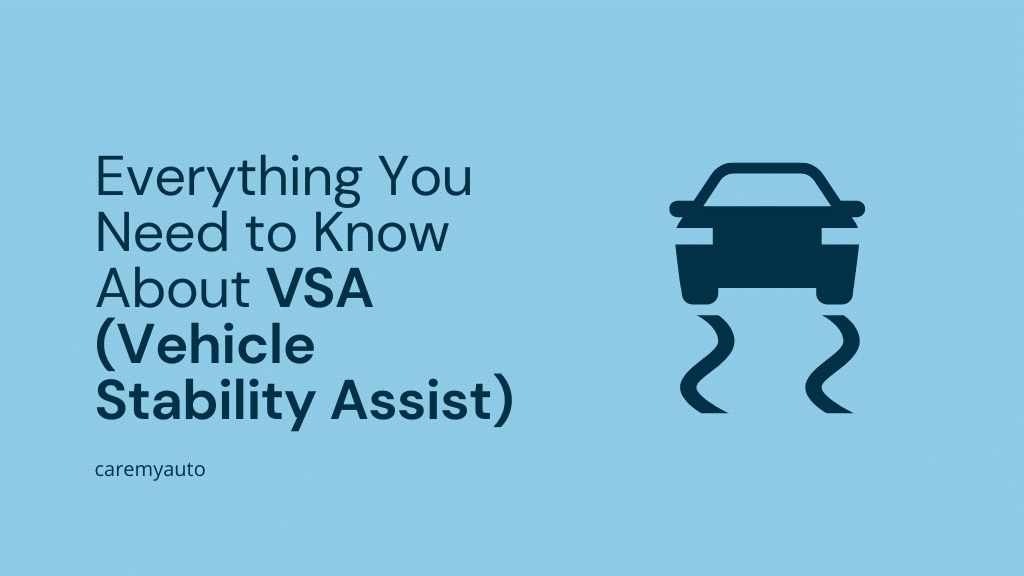Modern cars come with a lot of technology and are far better than the cars we used to drive years back. One such example of modern technology is the VSA or Vehicle Stability Assist. It can be seen in the latest Honda and Acura cars and can be very helpful to the driver.
It is very similar to the Traction Control System (TCS), wherein the system automatically slows down the slipping wheel by either cutting power to it or by applying brakes. Read on to find out more about how VSA works and what to do when the VSA light does not turn off.
What is Vehicle Stability Assist (VSA) System?
Vehicle Stability Assist (VSA) is a safety feature found in many modern vehicles that helps the driver maintain control of the vehicle in difficult driving conditions. VSA uses sensors and algorithms to detect when the vehicle is losing stability and then intervenes by applying brakes to individual wheels or adjusting the engine throttle to help the driver regain control.
The importance of vehicle stability cannot be overstated. In high-speed or slippery conditions, a loss of stability can lead to a dangerous or even deadly loss of control. VSA systems help to prevent these types of accidents by quickly and effectively responding to changes in the vehicle’s stability.
How does Vehicle Stability Assist (VSA) work?
VSA uses various sensors to gather data on the vehicle’s stability. These sensors can include accelerometers, gyroscopes, and yaw rate sensors, which measure the vehicle’s acceleration, rotation, and lateral movement, respectively. The data from these sensors is fed into algorithms that analyze the stability of the car and determine the appropriate intervention.
If the VSA system detects a loss of stability, it can intervene by applying the brakes to individual wheels to help the vehicle turn in the desired direction, or by adjusting the engine throttle to help the driver maintain control. The specific interventions used depend on the specific make and model of the vehicle, as well as the specific driving conditions.
What does the Vehicle Stability Assist (VSA) Light Mean?
The VSA (Vehicle Stability Assist) Light turns on when the VSA system has been activated. This typically occurs when the VSA system detects a loss of stability in the vehicle, such as when the car is skidding or sliding in a way that could lead to a loss of control.
The VSA system uses sensors to gather data on the vehicle’s stability, and if this data indicates that the vehicle is losing stability, the VSA system will intervene by applying the brakes to individual wheels or adjusting the engine throttle to help the driver regain control. The VSA Light serves as an indication to the driver that the VSA system is active and is working to maintain stability.
It is important to note that the VSA Light does not indicate a problem with the VSA system itself. Rather, it is an indication that the system is being used as designed to help maintain stability. If the VSA Light stays on or repeatedly turns on, it may be a sign of a problem with the VSA system or other components of the vehicle, and it is recommended to have the vehicle inspected by a mechanic.
What to do if the Vehicle Stability Assist (VSA) Light Stays On While Driving?
If the VSA (Vehicle Stability Assist) Light turns on or stays on in your vehicle, it is a sign that the VSA system has been activated or has a problem. To fix the issue, you will need to diagnose and address the underlying cause of the problem. There are several reasons why the VSA (Vehicle Stability Assist) light may stay on in a car, some of the common causes include:
- Faulty VSA sensors: The VSA system uses sensors to monitor the vehicle’s stability. If one of these sensors is malfunctioning, the light will stay on.
- Low tire pressure: Incorrect tire pressure can affect the VSA system, causing the light to stay on.
- New tires: If you recently installed new tires, make sure that they are all of the same sizes. The VSA Light turns on when not all the wheels are doing the same number of rotations.
- Brake system problems: If there is a problem with the brake system, such as worn brake pads or a malfunctioning brake sensor, the VSA light may stay on.
- Electrical issues: A problem with the vehicle’s electrical system can also cause the VSA light to stay on.
- Software malfunction: In some cases, a software malfunction can cause the VSA light to stay on.
It’s best to have the vehicle checked by a professional mechanic to determine the exact cause of the problem and to have it repaired. Keep in mind that the VSA system is an important safety feature, and it is essential to address any issues with the system promptly to ensure the safety of you and your passengers.
Advantages of Vehicle Stability Assist (VSA)
Well, there’s only one main advantage of the VSA system and if you were reading the article, then you probably know it already. And that advantage is that it improves safety in difficult driving conditions. By quickly and effectively responding to changes in stability, VSA helps to prevent accidents and keep drivers and passengers safe. In addition to the safety benefits, VSA also enhances the handling and control of the vehicle, making it easier to drive in challenging conditions.
VSA may also have the potential to reduce the severity of accidents that do occur. By intervening before a full loss of control occurs, VSA can help to slow the vehicle down and reduce the impact of any collision.
Final Thoughts
In conclusion, VSA is a valuable safety feature that helps to improve the stability and control of vehicles in difficult driving conditions. While there are limitations to the technology, the potential benefits in terms of improved safety and reduced accident severity make it an important consideration for any vehicle. As technology continues to develop, we may see even more advancements and improvements in the future.



